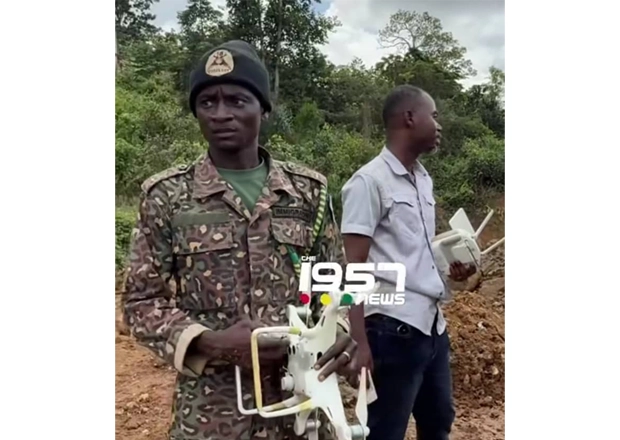The serene landscape of Kyebi, nestled within the East Akim Municipal Assembly of Ghana’s Eastern Region, became the backdrop for a stark illustration of the escalating conflict between environmental preservation and illegal mining. A Rocha Ghana, an environmental NGO at the forefront of combating “galamsey,” or illegal mining, deployed a drone for surveillance over the Birim River, a vital waterway increasingly ravaged by this destructive practice. The drone, intended to access treacherous terrains and monitor illicit mining activities, met a violent end at the hands of the very individuals it sought to expose. Galamsey operators, upon detecting the drone’s presence, shot it down, a brazen act highlighting the lengths to which they will go to protect their illegal operations. This incident underscores the growing challenges in curbing galamsey, a practice that has devastating consequences for Ghana’s environment and its people.
The downing of the drone was not merely an act of vandalism; it represents a direct assault on efforts to monitor and control illegal mining. The drone, equipped with sophisticated sensors and cameras, provided valuable data on the extent of environmental degradation caused by galamsey. Its destruction deprives environmentalists and law enforcement of a crucial tool in their fight against this illicit activity. The drone operator, recounting the event, described how the galamseyers, positioned on a vantage point, deliberately targeted the drone as it approached, demonstrating a calculated effort to obstruct surveillance. The retrieved wreckage, held by a security officer in a video circulated by The 1957 News, served as stark evidence of the audacity and aggression of the illegal miners.
The incident near the Birim River is unfortunately not an isolated occurrence. A Rocha Ghana, alongside other environmental organizations, has been consistently raising the alarm about the pervasive nature of galamsey and its devastating impact on Ghana’s natural resources. Illegal mining operations have polluted water bodies, decimated forests, and destroyed vital ecosystems. The Birim River, once a source of life and livelihood for local communities, is now increasingly threatened by the toxic runoff and sediment generated by galamsey. The environmental devastation left in the wake of these operations poses serious threats to human health, biodiversity, and long-term ecological stability.
A Rocha Ghana, undeterred by this setback, has vowed to identify and hold accountable those responsible for the destruction of the drone and the ongoing environmental damage. The organization, together with galamsey task forces, recovered some of the equipment used in the illegal mining operations, which will hopefully aid in the investigation. Moreover, A Rocha Ghana continues to advocate for stronger government action to combat galamsey. They have been vocal in their criticism of policies that they believe facilitate illegal mining, such as Legislative Instrument (LI) 2462, which permits mining in forest reserves. They argue that such legislation undermines environmental protection laws and exacerbates the galamsey problem.
Central to A Rocha Ghana’s recommendations is the implementation of a robust identification system for security personnel involved in anti-galamsey operations. This is crucial to prevent individuals falsely posing as national security operatives from exploiting the situation. The lack of clear identification creates confusion and potentially compromises the integrity of the operations. Furthermore, A Rocha Ghana has expressed concern over the pace of government action, stressing the need for a more urgent and decisive response to the galamsey crisis. They believe that the current measures are inadequate and lack the necessary urgency to effectively address the escalating environmental destruction.
The incident at the Birim River serves as a microcosm of the larger struggle to protect Ghana’s natural heritage from the ravages of illegal mining. The downing of the drone symbolizes the challenges faced by environmental organizations and the lengths to which galamsey operators will go to protect their illicit activities. A Rocha Ghana’s continued advocacy, coupled with the efforts of other stakeholders, is crucial in pushing for stronger regulations, more effective enforcement, and greater public awareness to combat this destructive practice and safeguard Ghana’s environment for future generations. The call for greater accountability and transparency in anti-galamsey operations, including the identification of security personnel, highlights the need for a comprehensive and coordinated approach to tackle this complex issue. Ultimately, the fight against galamsey is a fight for the future of Ghana’s environment and the well-being of its people.


